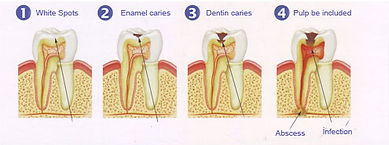top of page


Cavity Prevention
What is a Cavity?
A cavity is a breakdown in the tooth structure resulting in a hole or cavitation in the tooth. This can affect the tooth enamel (hard, white outer layer), the dentin (softer, yellow inner layer), and can eventually reach the nerve of the tooth causing an infection. Tooth decay is the second most common disease to affect humans after the common cold.
How does a cavity occur?
Cavities occur when there is an imbalance in the tooth’s demineralization and remineralization process. The tooth structure is made up of minerals and these minerals are constantly being leached from the tooth (demineralized) and replaced (Remineralized). When the tooth is losing minerals more than they can be replenished, a cavity may begin to form.


The first stage of a cavity is demineralization of the enamel. The tooth will appear white and chalky in this stage but there is no visible hole. As the decay process continues a hole will begin to appear and treatment of the cavity may be required.
Demineralization
Certain bacteria in our mouth feed on the sugar and carbohydrates in the foods and beverages we consume. These bacteria produce acid as a waste product and this acid causes the minerals to be leached out of our tooth structure. This is know as an 'Acid Attack'. The more frequently we expose our teeth to these acid attacks, the greater the risk we have of developing a cavity. Sugary drinks and sticky snacks can be particularly harmful.


Can Cavities Be Prevented or Healed?
Cavities are certainly preventable and can even be reversed in their earliest stage. We can prevent cavities by practicing good oral hygiene habits, using antimicrobial and remineralizing oral care products, reducing how frequently we consume sugary foods and drinks, and eating a well balanced diet.
Our Approach
We focus on prevention, early detection and minimally invasive early intervention to maintain healthy tooth structure.
Early Detection
Since we can remineralize the tooth structure in the earliest stage of tooth decay, it is critical that we identify a breakdown in tooth structure early. To detect early changes in the tooth structure, we use The Canary System. The Canary System uses Crystal Structure Diagnosis to identify changes in the tooth structure even before it can be seen on a dental x-ray. When caught early enough, we can focus on remineralization of the tooth structure and monitor the success of treatment with The Canary System. Early detection also allows us to offer less invasive treatment options, saving more of your natural tooth structure.
The Canary System
The Canary System is a painless, radiation-free, non-invasive low-powered laser that measures the crystal structure of the tooth to identify the presence of tooth demineralization, fractures, and early dental decay. It can identify decay in areas that are undetectable to the naked eye and in areas that are difficult to detect with dental x-rays.

All Videos
Prevention & Early Intervention
There are many ways to prevent decay and treatment plans are customized to each clients needs and may include:
-
Personalized oral hygiene instruction
-
Diagnostic scanning (The Canary System)
-
Nutritional counseling
-
Antimicrobial Thymol/Chlorhexidine varnish
-
Remineralization (fluoride and fluoride-free)
-
Povidone Iodine Treatment
-
Pit and Fissure Sealants
-
Silver Diamine Fluoride
-
Referral to DDS for cavity diagnoses and x-rays
** Diagnosing and treating dental cavities is not within the dental hygiene scope of practice and it is recommended that you see a dentist regularly for your dental exam and x-rays**
bottom of page
